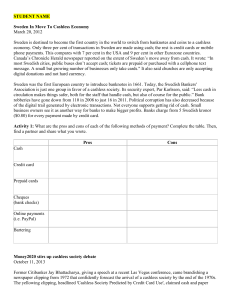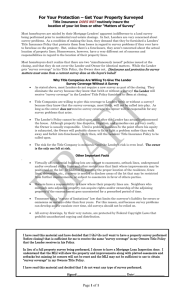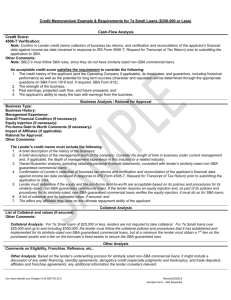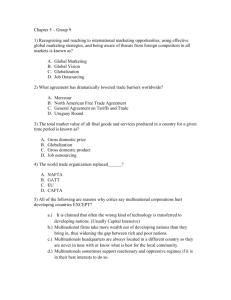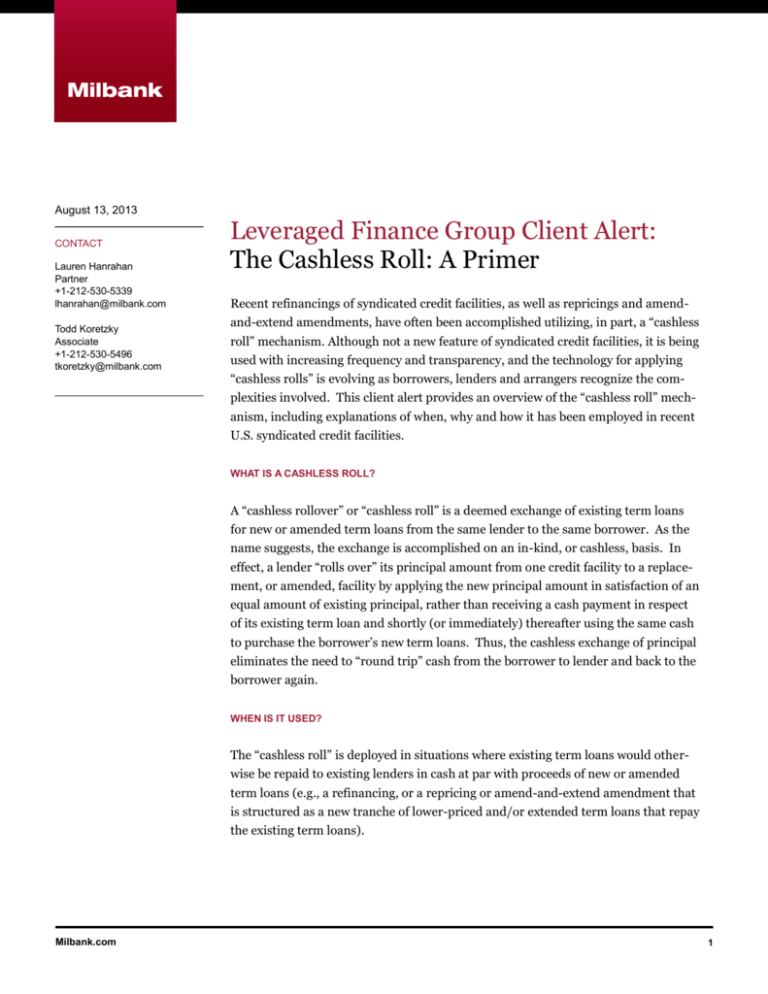
August 13, 2013
CONTACT
Lauren Hanrahan
Partner
+1-212-530-5339
lhanrahan@milbank.com
Todd Koretzky
Associate
+1-212-530-5496
tkoretzky@milbank.com
Leveraged Finance Group Client Alert:
The Cashless Roll: A Primer
Recent refinancings of syndicated credit facilities, as well as repricings and amendand-extend amendments, have often been accomplished utilizing, in part, a “cashless
roll” mechanism. Although not a new feature of syndicated credit facilities, it is being
used with increasing frequency and transparency, and the technology for applying
“cashless rolls” is evolving as borrowers, lenders and arrangers recognize the complexities involved. This client alert provides an overview of the “cashless roll” mechanism, including explanations of when, why and how it has been employed in recent
U.S. syndicated credit facilities.
WHAT IS A CASHLESS ROLL?
A “cashless rollover” or “cashless roll” is a deemed exchange of existing term loans
for new or amended term loans from the same lender to the same borrower. As the
name suggests, the exchange is accomplished on an in-kind, or cashless, basis. In
effect, a lender “rolls over” its principal amount from one credit facility to a replacement, or amended, facility by applying the new principal amount in satisfaction of an
equal amount of existing principal, rather than receiving a cash payment in respect
of its existing term loan and shortly (or immediately) thereafter using the same cash
to purchase the borrower’s new term loans. Thus, the cashless exchange of principal
eliminates the need to “round trip” cash from the borrower to lender and back to the
borrower again.
WHEN IS IT USED?
The “cashless roll” is deployed in situations where existing term loans would otherwise be repaid to existing lenders in cash at par with proceeds of new or amended
term loans (e.g., a refinancing, or a repricing or amend-and-extend amendment that
is structured as a new tranche of lower-priced and/or extended term loans that repay
the existing term loans).
Milbank.com
1
WHY IS IT USED?
The “cashless roll” mechanism was initially developed to accommodate certain institutional investors that preferred this funding mechanism to loan repayment for convenience and other reasons. For several years, the “cashless roll” was used sparingly.
“Cashless rolls” are now frequently offered to all existing lenders in credit facilities
being refinanced, repriced or extended.
WHO IS INVOLVED?
The “cashless roll” requires an agreement between the borrower and the “rolling”
lender. However, the administrative agent for both the existing and new or amended
facilities must also be willing to handle its implementation.
When arranging the new or amended facility, the arranger, in consultation with the
borrower, will determine whether a sufficient need (or desire) exists to warrant offering the “cashless roll” option to any or all existing lenders for purposes of facilitating syndication of the new or amended facility. In making this determination, arrangers consider various factors including expectations regarding the syndication of
the new facility, investor demand and the administrative burdens involved.
In refinancing transactions, there should be no need for consent or participation by
any other lender(s) in connection with a “cashless roll” by a “rolling” lender. From a
non-“rolling” lender’s perspective, all existing term loans, including its own, are
simply repaid by the borrower (presumably but not necessarily in cash) and the existing credit facility is terminated. In the amendment context, aside from lender approval of the amendment transaction generally, non-“rolling” lenders do not vote on
any other lender’s election and utilization of the “rollover” option.
HOW IS IT IMPLEMENTED?
The “cashless roll” mechanism varies from deal to deal. It may be accomplished by
the express terms of an amendment (often with each lender presented with the option to select, on its signature page, a “cashless rollover” for all or a portion of its existing term loans) or by a separate letter agreement, executed concurrently with the
proposed refinancing or amendment, between the existing lender and the borrower
and acknowledged by the administrative agent(s). In each case, the borrower offers
to exchange an aggregate principal amount of existing term loans outstanding immediately prior to the closing of the transaction, for the allocation of new or amended term loans in the initial syndication of the new or amended credit facility. Any
interest and non-principal amounts owing by the borrower to the “rolling” existing
lender in respect of the existing term loans (including any call premium payable on
MILBANK CLIENT ALERT: Leveraged Finance Group
August 13, 2013
2
the existing term loans) and any consent fees or upfront fees (including amounts
that might otherwise be treated as original issue discount) in respect of the new term
loans are typically paid in cash by the borrower. As a result, although intended to
reduce the number of cash payments at closing (i.e., by “rolling” certain principal
amounts forward on a cashless basis), the flow of funds in a transaction involving a
“cashless roll” option can actually become quite complex.
WHAT ARE THE KEY TERMS?
The documentation for “cashless rolls” continues to develop. “Cashless roll” letter
agreements and amendment provisions typically contemplate that, in order to memorialize the deemed exchange, the administrative agents will mark the registers to
reflect both the cancellation of the exchanged amount of existing term loans and the
inclusion of each “rolling” lender as a party to the new or amended credit agreement
immediately following the occurrence of the closing date. For this reason, the administrative agent(s) for both the existing and the new or amended credit facilities
are required to accept and acknowledge such letter agreement or amendment provision. In contrast, in the case of refinancings that are “fronted” by a lead arranger, all
new, non-“rolling” term lenders in primary syndication will generally become lenders shortly after the closing date via an assignment of their allocated term loans from
the arranger that fronted the new or amended term loans on the closing date. Possibly for this reason, “cashless roll” letter agreements or amendment provisions often
also state that the “cashless roll” satisfies the requirements of an assignment agreement under the terms of the new or amended credit agreement, although a “cashless
roll” is not technically an assignment.
Aside from the funding mechanics of “cashless rolls”, “rolling” lenders are not entitled to any additional substantive rights or benefits under the credit facilities as
compared to other lenders under either the existing or new or amended credit facilities. Moreover, although “rolling” lenders are entitled to any call protection otherwise applicable to their term loans being “rolled over”, they typically waive their
rights to reimbursement of LIBOR “breakage” costs associated with the early retirement of such term loans.
Other transaction documents may be affected by the “cashless roll” mechanism as
well. The payoff letter for the facility being refinanced may need to be modified to
contemplate a portion of the outstanding loans being repaid on a cashless basis and
not by wire transfer. Similarly, any co-arranger fronting letter may be modified to
contemplate a smaller fronted amount than if the entire new term loan were disbursed by the fronting bank in cash. Credit agreements themselves may begin to
include provisions intended to facilitate lenders becoming party pursuant to the
MILBANK CLIENT ALERT: Leveraged Finance Group
August 13, 2013
3
“cashless roll” mechanism in addition to the traditional means of signing the credit
agreement at closing or purchasing loans pursuant to an assignment agreement.
POINTS OF CONSIDERATION
The following highlights certain elements of a “cashless roll” that warrant particular
attention:
1.
Exchanged Amount. The exchanged amount, in the easiest formulation,
consists of the “rolling” existing lender exchanging all of its existing term loans for
the same amount of the new or amended term loans. However, if syndication of the
new or amended term loans results in a significant oversubscription, the arranger of
the new transaction may wish to reduce the allocation of the “rolling” existing lender
in the new deal (as compared to its holdings in the existing deal), in which case the
exchanged amount will be less than the full amount of the “rolling” lender’s existing
term loans and the “rolling” lender will also receive a cash repayment of its existing
term loans in an amount equal to the amount of its existing term loans that is greater
than its exchanged amount. Similarly, the “rolling” existing lender may elect not to
“cashlessly roll” all of its existing term loans or the new term loan facility might be
smaller than the existing term loan facility, which scenarios also necessitate a partial
cash repayment of such lender’s existing term loans in an amount equal to the excess
above the exchanged amount. On the other hand, the “rolling” existing lender may
wish to increase its allocation, in which case such lender will fund new loans in addition to exchanging all of its existing term loans.
2.
Identity of the Existing and New Lenders in a Common Family. The arrang-
er of the new transaction (and the “rolling” existing lender) must also track the identity of each “rolling” existing lender in any group of affiliated lenders (i.e., funds and
sub-funds of the same institution) that desires to “roll over” its loans. To the extent
of any downsizing or upsizing of the existing lender’s allocation in the new or
amended transaction and any cash payment of fees, interest, premium and/or other
amounts, the arranger must track, and pay, each entity separately on the transaction’s flow of funds memorandum.
3.
Rights During Interim Period. Although the “cashless roll” is designed to
occur concurrently with closing, the “rolling” lender does not sign the new or
amended credit agreement, and thus may not be considered a lender of record under
the new or amended facility immediately upon its effectiveness. Instead, the “rolling” lender becomes party to the new or amended facility pursuant to the deemed
exchange of its “rolled” term loans and the registration of that exchange by the administrative agent promptly following the effectiveness of the new or amended credit
facility. During this interim period, which should be only a moment in time, the ini-
MILBANK CLIENT ALERT: Leveraged Finance Group
August 13, 2013
4
tial term loan lender (i.e., the fronting bank) may be treated as the lender of record
of the “rolled” term loans and may vote such “rolled” amounts in an amendment to
approve the amended credit agreement into which the loans are “rolled-over”. All
other rights and benefits attaching to the “rolled” loans (such as the right to receive
accrued interest) should transfer to the “rolling” lender immediately upon the consummation of the deemed exchange contemplated by the “cashless roll”.
4.
Tax Effects. From a tax perspective, the “cashless roll” option is generally
treated as a funding mechanic, rather than a separate taxable transaction. In the
event that there is a significant amount (more than 10% of the aggregate principal
amount) of new lender money involved in the amendment or refinancing, the purchase price paid by the new lenders will set the “issue price” for tax purposes for all
lenders (including the “rolling” existing lenders).
CONCLUSION
Suffice to say, “cashless rolls” seem to be here to stay – what was once a one-off accommodation designed for certain institutional investors has now become a mainstream feature of U.S. syndicated term loan refinancings. In order to avoid the need
to untangle any unintended consequences, understanding the mechanics of the
“cashless roll”, the related legal documentation and its implications is important for
borrowers, lenders, arrangers and agent banks alike.
MILBANK CLIENT ALERT: Leveraged Finance Group
August 13, 2013
5
LEVERAGED FINANCE GROUP
Please feel free to discuss any
aspects of this Client Alert with
your regular Milbank contacts or
any of the members of our
Leveraged Finance Group.
If you would like copies of our
other Client Alerts, please visit our
website at www.milbank.com and
choose “Client Alerts” under
“News.”
This Client Alert is a source of
general information for clients and
friends of Milbank, Tweed, Hadley
& McCloy LLP. Its content should
not be construed as legal advice,
and readers should not act upon
the information in this Client Alert
without consulting counsel.
© 2013 Milbank, Tweed, Hadley
& McCloy LLP.
All rights reserved.
Attorney Advertising.
Prior results do not guarantee a
similar outcome.
NEW YORK
One Chase Manhattan Plaza, New York, NY 10005
Michael Bellucci
mbellucci@milbank.com
+1-212-530-5410
Marcus Dougherty
mdougherty@milbank.com
+1-212-530-5323
Marc Hanrahan
mhanrahan@milbank.com
+1-212-530-5306
Lauren Hanrahan
lhanrahan@milbank.com
+1-212-530-5339
Douglas Landy
dlandy@milbank.com
+1-212-530-5234
LONDON
10 Gresham Street, London EC2V 7JD, England
Neil Caddy
ncaddy@milbank.com
+44-20-7615-3145
Suhrud Mehta
smehta@milbank.com
+44-20-7615-3046
FRANKFURT
Taunusanlage 15, Frankfurt am Main 60325, Germany
Thomas Ingenhoven
tingenhoven@milbank.com
+49-69-71914-3436
Rainer Magold
rmagold@milbank.com
+49-69-71914-3430
MILBANK CLIENT ALERT: Leveraged Finance Group
August 13, 2013
6

